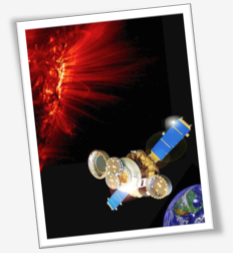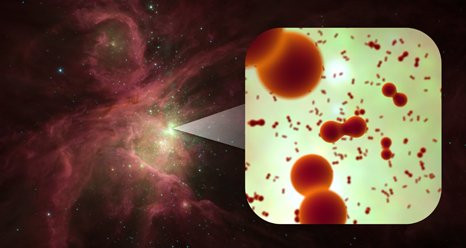Lately, the International Space Station has been flying through geomagnetic storms, giving astronauts an close-up view of the aurora borealis just outside their windows.
Link to the NES Virtual Campus home page.
Lately, the International Space Station has been flying through geomagnetic storms, giving astronauts an close-up view of the aurora borealis just outside their windows.
Link to the NES Virtual Campus home page.
The leading edge of the March 6 coronal mass ejection, or CME, reached NASA’s Advanced Composition Explorer, or ACE satellite at 5:42 a.m. EST this morning. ACE sits just outside of Earth’s magnetic environment, the magnetosphere. As magnetic fields from the CMEs connected up to the magnetosphere, instruments on Earth began to measure changes in our planet’s magnetic fields – indicating the onset of a geomagnetic storm.
NASA models using data from the Solar Terrestrial Relations Observatory, or STEREO, and the Solar Heliospheric Observatory, or SOHO have now provided more information about the two CMEs associated with the March 6 flares. The first is traveling faster than 1,300 miles per second; the second more than 1,100 miles per second. NASA’s models predict that the CMEs will impact both Earth and Mars, as well as pass by several NASA spacecraft – Messenger, Spitzer, and STEREO-B. The models also predicted that the leading edge of the first CME will reach Earth at about 1:25 a.m. EST on the morning of March 8 (plus or minus 7 hours). Such a CME could result in a severe geomagnetic storm, causing aurora at low latitudes, with possible disruption to high frequency radio communication, global positioning systems (GPS), and power grids.
This movie of the March 6, 2012 X5.4 flare was captured by the Solar Dynamics Observatory (SDO) in the 171 Angstrom wavelength. One of the most dramatic features is the way the entire surface of the sun seems to ripple with the force of the eruption. This movement comes from something called EIT waves – because they were first discovered with the Extreme ultraviolet Imaging Telescope (EIT) |
Surprising but true: Every day, on average, more than 40 tons of meteoroids strike our planet. Most are tiny specks of comet dust that disintegrate harmlessly high up in Earth’s atmosphere, producing a slow drizzle of meteors in the night sky. Bigger chunks of asteroid and comet debris yield dozens of nightly fireballs around the globe. Some are large enough to pepper the ground with actual meteorites.
The GOES series of satellites provide continuous (every 30 minutes) satellite information for the U.S. and are critical during hurricane season. GOES-11 and GOES-13 provide infrared and visible satellite data over the western and eastern U.S. and eastern Pacific and Atlantic Ocean. The 2011 hurricane season is now available in one 4.5 minute video from NOAA. GOES satellites are operated by the National Oceanic and Atmospheric Administration. NOAA just released a video from the GOES-13 satellite that takes the viewer through all 19 tropical cyclones that formed in the 2011 Atlantic Hurricane Season. Supplemental animations and images were also created by NASA’s GOES Project. Those animations show activity in each month of the 2011 hurricane season. September (below) puts on the best show, with several storms circling clockwise around the Bermuda High.
NASA’s Kepler mission has confirmed its first planet in the “habitable zone,” the region where liquid water could exist on a planet’s surface. Kepler also has discovered more than 1,000 new planet candidates, nearly doubling its previously known count. Ten of these candidates are near-Earth-size and orbit in the habitable zone of their host star. Candidates require follow-up observations to verify they are actual planets.
To read more about this discovery go to https://www.nasa.gov/mission_pages/kepler/news/kepscicon-briefing.html
Link to the NES Virtual Campus home page.
 Analysis from NASA’s Genesis mission indicates our sun and its inner planets may have formed differently than previously believed.
Analysis from NASA’s Genesis mission indicates our sun and its inner planets may have formed differently than previously believed. Detectors on the Herschel Space Observatory’s large telescope have provided the first confirmation of oxygen molecules in space. The molecules were detected within the Orion Nebula.
Detectors on the Herschel Space Observatory’s large telescope have provided the first confirmation of oxygen molecules in space. The molecules were detected within the Orion Nebula.Link to the NES Virtual Campus participant’s home page.
 The sun unleashed an M-2 (medium-sized) solar flare with a spectacular coronal mass ejection, or CME, on June 7, 2011. The large cloud of particles mushroomed up and fell back down looking as if it covered an area of almost half the solar surface.
The sun unleashed an M-2 (medium-sized) solar flare with a spectacular coronal mass ejection, or CME, on June 7, 2011. The large cloud of particles mushroomed up and fell back down looking as if it covered an area of almost half the solar surface.Link to the NES Virtual Campus home page.
 NASA’s Voyager probes are truly going where no one has gone before. Gliding silently toward the stars, 9 billion miles from Earth, they are beaming back news from the most distant, unexplored reaches of the solar system.
NASA’s Voyager probes are truly going where no one has gone before. Gliding silently toward the stars, 9 billion miles from Earth, they are beaming back news from the most distant, unexplored reaches of the solar system.Read more about this amazing discovery at Science@NASA or watch the video on YouTube.
Link to the NES Virtual Campus home page.
 In this episode, Kurt Sacksteder, Chief of the Space Environments and Experiments Branch at NASA’s Glenn Research Center talks about the importance of water on other planets and the tools being developed to mine water from Martian soil. NASA is working with a Canadian mining and space technology company to test designs for excavating natural resources from the surface of planets like Mars. They take measurements of forces applied to excavation devices, the traction of evacuation vehicles and even the flow of sand during simulated digs.
In this episode, Kurt Sacksteder, Chief of the Space Environments and Experiments Branch at NASA’s Glenn Research Center talks about the importance of water on other planets and the tools being developed to mine water from Martian soil. NASA is working with a Canadian mining and space technology company to test designs for excavating natural resources from the surface of planets like Mars. They take measurements of forces applied to excavation devices, the traction of evacuation vehicles and even the flow of sand during simulated digs.
Watch a preview of this episode below. Previews of other NASA Now episodes are on the NASA Explorer Schools channel on YouTube.
Link to the NES Virtual Campus home page.
NASA Now Minute: Mars Excavation